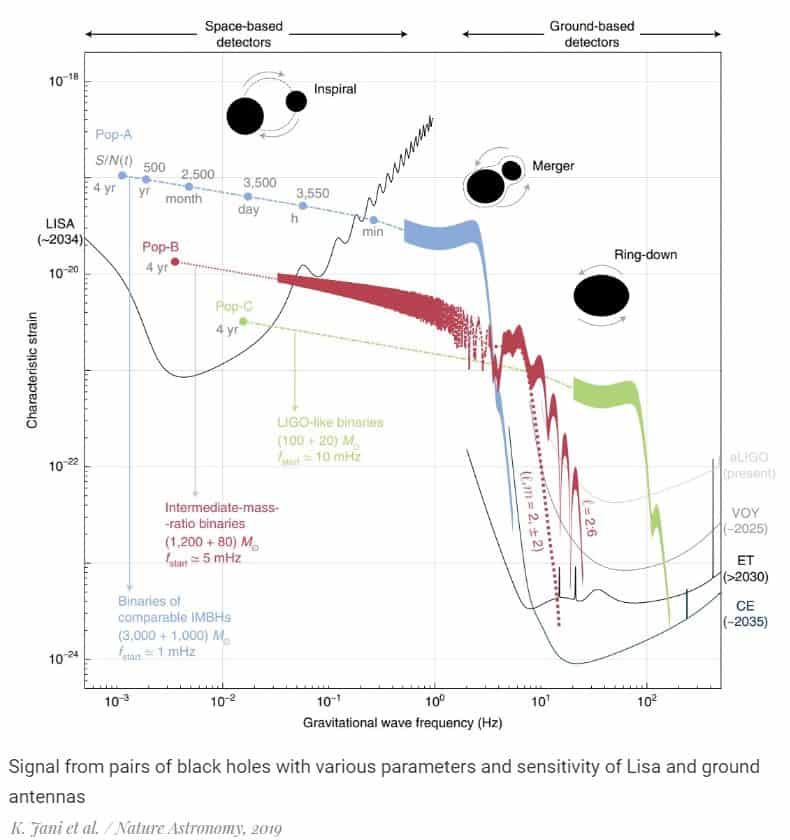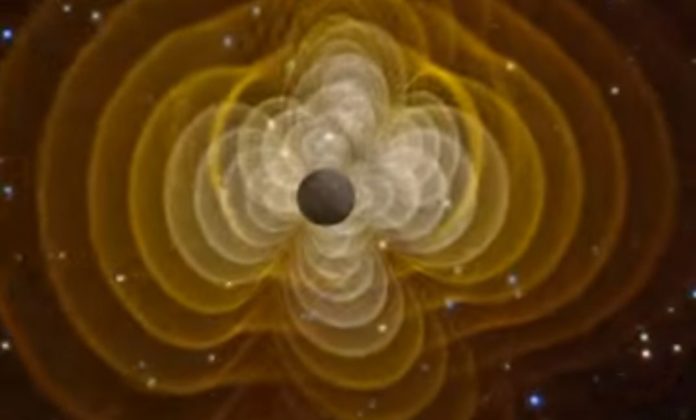A new study led by Karan Jani with his team calculated the possibilities of simultaneous observation of gravitational waves using terrestrial and cosmic interferometers to search for signals of black holes in the intermediate-mass range. The joint work of different detectors will allow observing all stages of mergers for many different configurations of objects, according to the authors.
Astronomers identify three main types of black holes, differing in history of formation and observational manifestations: black holes of stellar masses, supermassive and intermediate. The existence of the first two varieties is firmly established by a variety of testimonies. The third type has long avoided registration, and although several suitable candidates have already been found, the properties of the population of such black holes remain unknown.
Existing gravitational wave detectors (LIGO in the United States, Virgo in Europe and KAGRA in Japan) are sensitive to space-time fluctuations with frequencies of about tens and hundreds of hertz. This narrows the range of possible signal sources to the merger of the smallest objects capable of generating a sufficiently powerful gravitational signal, i.e. up to neutron stars and black holes are no heavier than 50 Suns. Other types of objects, i.e. black holes of intermediate masses or close double white dwarfs, require other receivers that will be much more effective to wave lower frequencies.
A study led by astrophysicist Karan Jani has assessed the potential of observations of black holes of intermediate masses through joint observations on ground antennas, as well as LISA space facility under development, which is scheduled to be launched in 2034. Scientists divided possible merging pairs into several classes, and analyzed the data taking into account the likely improvement of working ground antennas and commissioning by 2034 new ones, such as the Einstein Telescope and the Cosmic Explorer.

The authors call the observation multi-band, if the signal of one pair of objects can be observed from space at the stage of convergence, and on Earth – at the stage of fusion or subsequent “ringing” event horizon (ringdown). For the merger of two black holes with masses of about a thousand solar radius registration can exceed 40 gigaparsecs, which corresponds to a red embarrassment of more than 4. Such a large removal theoretically allows studying the hypothetical formation of black holes of intermediate masses as a result of explosions of the oldest stars of Generation III.
For the second group with a large mass difference, the detection radius at best will not greatly exceed 10 gigaparsecs. This is due to the relatively small energy released during the merger, which will make these events difficult to observe at ground installations. With less successful combinations of parameters, such as a very large mass difference (for example, 10,000 and 100 solar masses), detection will be possible only up to hundreds of megaparsec. However, the characteristics of radiation, in this case, make it possible to verify with high accuracy the theoretical concepts of black holes, such as the theorem on the absence of hair.
For the third type of mergers, in which a pair of black holes are involved, one of which is of stellar mass, and the other of about 100 solar masses, the possibility of registration will be limited by high-frequency LISA noises, rather than ground installations. In this case, multi-band observations will also be possible up to relatively small distances of a couple of hundred megaparsecs. It is also possible that the signal at the approaching stage will be at the noise level in the LISA data, and only due to the restoration of the parameters after observing the merger at the ground-based installations, it will be possible to isolate the signal at the early stage.
The authors conclude that for any combination of parameters, the best option would be the simultaneous operation of Lisa in space and the Einstein Telescope on Earth. However, even the abolition of third-generation ground-based receivers will make it possible to confidently observe events involving black holes of up to 2000 solar masses. Detection of such events will finally prove the reality of such objects and will make it possible to find out the properties of their population, and the absence of the desired signals will establish estimates for the rate of mergers.
